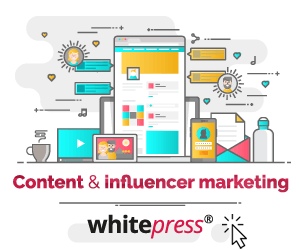Getting into professional blogging reminds riding on a roller-coaster: sometimes it can be scary, sometimes it may be really exciting, sometimes you shout – or in contrary, you stay quiet, but in the end, you are delighted with your ride.

Blogging is not the easiest nut to crack, but monetising options can take you places. Once you establish your position and the style of writing and open up for advertising possibilities, you may get your first commercial offers. Some of them will include writing a sponsored article… and here we come.
Writing a sponsored article may seem to be the same story as writing your regular blog post. However, there are a few differences you definitely should take into account. In this article, you will get familiar with a checklist of what to do before, during and when you finish writing to ensure that your Client will be satisfied, and would come back for more sponsored articles or recommend you further.

Checklist – before you start writing
Getting prepared at this stage can make your work easier and quicker. You should check at least a few additional things before you agree on collaboration.
Verify your potential client
Your clients check you from head to toe, be sure about that. And you are fully entitled to do the same! You should respect your time and your audience. Bloggers often accept each offer they get, which is a significant mistake. As a blogger, you ought to do your best to investigate and check if a particular brand is a good fit for what you publish and who you engage.
If the brand was involved in a social media crisis, if they had a bad press and their reputation is not the greatest or their latest campaigns are offputting, and against your opinion, you may want to skip collaboration to save your reputation. Sometimes, though, brands don’t have to do anything wrong to just not be the best match with the profile of your blog. The industry that you don’t have a clue of, unappealing products or services that you are not the best person to promote, despite your reach. Brands often make a mistake of choosing collaborating bloggers by basing only on their reach, while it is not the path to success and can cost a lot: not only a lot of money. Selecting smaller, but more specialised influencer can be more beneficial both for brands and for bloggers trying to sparkle.
Check your manpower and time
Before you say “yes” to the collaboration, check if you can fully dedicate to a project. If you have no time to deliver the best possible quality, maybe it would be a better idea to drop the cooperation or reschedule it for better times. This may not be seen as a professional move, but it’s still more professional than running an unsuccessful campaign, in a rush and with a lack of precision. After all, brands are able to pay a lot of money, and they would not like to burn it on a pretty dismal campaign.
It is ok not to be ok with your time as long as you spill the beans to a brand, too. Looking for excuses while the cooperation is already in progress in not elegant and can impact your branding as well as further collaboration.
Check your NDA
This point is vital for those who have already executed a few advertising campaigns using their blogs, vlogs or websites. As long as for publishing many sponsored content pieces you don’t need any Non-Disclosure Agreements, some brands can require it to ensure you wouldn’t get into cooperation with their competitors. It is entirely understandable from their point of view, but it imposes additional obligations on you. Usually, NDA lasts up to a few years, which in the online world is a lot. Always check them before you sign another agreement.

Checklist – while you are writing
There’s gotta be more than just writing and choosing fonts, right? You need to take a few factors into consideration when you write each and every word. Mistakes at this stage can cost you a lot of time, but sometimes even money.
Tell your audience
Marking sponsored articles as part of paid collaboration is seen in good taste. Your followers should know that a particular piece of content is an outcome of cooperation with some brands. This is just fair for those who follow your every blog-step.
Influencers often mark sponsored posts in headers or footers, in the end, or the beginning of the post. This gives precise information about the goal of a post, and your audience won’t feel like you were lying to them from the very start.
Be natural
Your loyal followers will easily recognise if you lie to them. Reviewing the product you have never used before, or recommending a place that is not even located in your county can be regarded as a lie and offence to your audience. They may turn their backs from you and never come back.
Your message has to be natural, not-biased (no one these days will believe you that a random product suddenly saved your life), but positive. Also, it has to be presented in your unique style.
Be informative
No, your post shouldn’t look like a written TV ad which annoys everyone. Tell a story, but be informative. Try to attract your followers, without being cheesy or pushy. Sell that story, but without selling yourself.
Keep the structure
Plan ahead how your sponsored article should look like. Is there any particular structure your blog posts have, or the article requires? If you need to enhance your blog post or website post with photos, plan it in advance. Did you include all necessary subtitles, pictures and links your Client asked you for?
Also, take care of the quality of your publication. Make not only your Client but mainly the audience want to read your post. Make it appealing, attractive and worth spending a few minutes for. People are getting more aware of ad clutter, and they don’t like wasting time on the Internet – don’t make them think that they do.
Be precise as for word count, headlines, ALT texts, meta description. These things can easily be checked with various extensions for, e.g. WordPress.
Obey the rules
Brands tend to deliver a list of rules to obey and mistakes to avoid. Before you press “publish”, it is good to send your article to the brand for approval and proofreading. Why? It is better to do it then than correcting after publication. You need to draw your attention to details and double check names, fonts or links. If the brand gave you some keywords or materials, they care about and would like to show, you could use them. Show the brand in a good way and be responsive – if the campaign has a higher reach than you expected, you may need someone from client’s side to support requests.
What can be really important in this point is putting affiliate links. If you got them from your Client, be sure that they are tagged with UTMs to help with tracking conversion. Ensure yourself they work, and a possible purchase is available. Nobody wants to drive massive traffic to the shop that doesn’t work correctly: it impacts both shops (they may be found unprofessional) and a blogger (“they haven’t even checked it – the store doesn’t work, I can’t make a purchase!). Don’t make yourself extra work by answering all complaints about something you may have no influence on.
Plan the distribution
Publishing may not be enough for achieving the success. You should plan additional activities to increase the reach of publication. Scheduling social media posts to redirect your audience to a particular post may be a good idea and would save you time later, when you will be busy with responding to your followers’ question. To automate this process a bit, you can use tools like Kontentino to plan your distribution in one place and one go.
Repurpose your content. Even if a sponsored article is in the form of text, no one should say “no” to redistributing it by using animations, photos, charts or other types of interactive content. Some forms work visibly better on specific platforms – for example, Facebook seems to support videos widely, so it’s worth giving a go to an animated sneak peek and see how it performs.

Checklist – when you publish
You published your sponsored article? Well done, but the collaboration is not over yet. We would even say it has already started – you need to keep an eye on your content and bring serious analysis into life.
React
You need to be prepared on reactions – both positive and negative. Being responsive helps with dealing with complaints and requests, and will be warmly welcomed by a brand as well. By acting quickly, you can prevent any possible social media crisis, answer your followers’ needs quickly and be seen as a dedicated to project person. Brands like influencers who get engaged in communication also after publishing a particular piece of content. This could be a unique opportunity to shine for you, and a real win-win-win situation. The brand will regard you as a responsible, reliable blogger to collaborate with, you will take care of a shape of a campaign and strengthen your relations with followers, your followers will consider you as a great example of whose advertising content they want to see, and they are not disturbed by!
Analyse
Analysing is vital. Not only can give you some important information on how your content performed, not only it can be delivered to your Client, but also can be a creative well of inspiration for you and your next campaigns. You should test out some forms of content, check out what works and what doesn’t and measure the reach and engagement metrics.
Report
Don’t forget about sending an extensive report including all necessary data, statistics and conclusions. The form of aesthetic, clear PDF with transparent information will be highly appreciated by your Client who can find it professional.
We hope that our article was of help for you! It is not easy to deliver a top-notch article, but with our checklist, it may be at least a bit easier. If you are looking for more exposure, opportunities to write and clients to gain, you should give some content marketplaces a try: Whitepress.net is just one of them. Offering your services there, you give yourself a chance for successful collabs.









